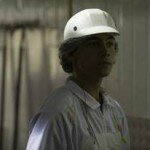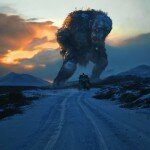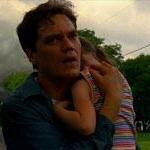![Daniel+Nettheim+Hunter+Portraits+2011+Toronto+fwDOxrlt2aWl[1] daniel+nettheim+hunter+portraits+2011+toronto+fwdoxrlt2awl1 333x500 Interview: Daniel Nettheim, director of THE HUNTER](/wp-content/uploads/daniel+nettheim+hunter+portraits+2011+toronto+fwdoxrlt2awl1-333x500.jpg) Australian director Daniel Nettheim has helmed his fair share of TV episodes in the form of Rush and All Saints, but it’s been over a decade since he’s made a feature film. He returns to the big screen with The Hunter, a mystery drama about a US mercenary (Willem Dafoe) who is sent to the Tasmanian wilderness to track down the supposedly extinct Tassie Tiger. Adapted from the novel of the same name by Julia Leigh, the film co-stars Sam Neill and Frances O’Connor, the former accompanying Nettheim and Dafoe to the Toronto International Film Festival for the film’s debut..
Australian director Daniel Nettheim has helmed his fair share of TV episodes in the form of Rush and All Saints, but it’s been over a decade since he’s made a feature film. He returns to the big screen with The Hunter, a mystery drama about a US mercenary (Willem Dafoe) who is sent to the Tasmanian wilderness to track down the supposedly extinct Tassie Tiger. Adapted from the novel of the same name by Julia Leigh, the film co-stars Sam Neill and Frances O’Connor, the former accompanying Nettheim and Dafoe to the Toronto International Film Festival for the film’s debut..
Now that The Hunter is in cinemas across Australia, we spoke with Nettheim over the phone about his journey making the film, from the decade long pre-production process to working with Willem Dafoe, child actors and Mother Nature.
—
Cut Print Review: First of all, congratulations on premiering your film at Toronto [International Film Festival] last month. Was that the first time you got to sit in with an audience and watch it?
Daniel Nettheim: Absolutely, I hadn’t seen the film for over three months! As soon as we finished post-production, I went off and worked on a television series, which was pretty time consuming. So I didn’t get to go to any of the early screenings of the prints. So yeah, I kind of came to it fresh at Toronto.
CPR: What was it like returning to the film some three months later with a fresh set of eyes? Was it a liberating experience, or was it more a case of “let’s go back to the editing room on that bit”?
DN: It was the opposite, actually. When we were finishing the film, I was so tightly focusing on every minute detail that I kind of lost track of the bigger picture. When I saw it after three months, I could just relax into it and enjoy the journey and appreciate all the smaller parts contributing to an overall whole.
CPR: The cinematic bible IMDb tells me that you directed a romantic comedy Angst over a decade ago, and since then have directed a wide range of TV shows until you took on The Hunter. Is there any particular reason why you took a decade to make another feature?
DN: Yeah look, it seems like a long time, but throughout that period, the film was always moving forward. At a snail’s pace, sure, but there was always something happening. I guess one of the things that holds you up is that you need to pay people to write drafts for scripts, which is difficult when you don’t have a ready source of money. So you apply to Screen Australia for development money and it takes two months to get that application in, to get it processed and then, you know, it can be up to six months for a draft to be written.

CPR: So The Hunter has been a decade in the making?
DN: Yeah, definitely. I think about eight years of it was just the development of the script, but you know, we’re always doing other things at the same time. But once Willem Dafoe came on board, then it was a very rapid two years.
CPR: Yeah, I bet! What exactly did snagging a big name like Willem Dafoe mean for you and the project?
DN: What it meant was that it because much easier to finance the film. We got to the stage where we had a really good script and we were going out to investors to try and raise funds, but the reoccurring question was: “Ok, but who is going to play Martin David?”
He’s in almost every scene, so people really wanted to know. So once we could turn around and say “Willem Dafoe is The Hunter,” then they got it. From there, it all kind of fell into place pretty rapidly.
CPR: Willem is hardly a stranger to daring roles, but you really put him through his paces both mentally and physically in this film. What kind of preparation and training did he undergo in order to convince as a seasoned hunter?
DN: One of the more specific things was learning how to make all those traps. So we spent a bit of time with a wilderness survival expert who taught Willem specific skills like how to move through the landscape, you know, without disturbing the animals. Also, how to walk with the softest foot possible, how to listen, how to observer and how to make some of those beautiful, primitive snares that you see! [laughs] No, but that process was a real eye-opener for all of us.

CPR: Alongside Willem, the Tasmanian wilderness is really the star of this movie. You’re truly at the mercy of the elements when making a movie like this. Did Mother Nature play fair during the shoot?
DN: We were prepared for any eventuality with the weather. I knew that in certain locations, or in certain parts of the story, I wanted certain weather conditions. So we structured the shoot so that we could always be immediately responsive to changes in the weather; we’d always have standby scenes ready to go. For example, we were up on the top of Mount Wellington when we were caught in an unexpected snow blizzard, but since I had these scenes that I knew I wanted to shoot in the snow, we were able to go “Ok, let’s stop what we’re doing and go and shoot the snow scenes now.”
To help us be able to do this, we made a decision early on that Willem’s character Martin only ever has one wardrobe; one outfit whenever he’s in the wilderness. So we could stop and change scene at any point without having to worry about some wardrobe changes. But also, you know, once we were back in the edit room, we could swap things around without causing big continuity problems.
CPR: The Hunter also stars young Morgana Davies and Finn Woodlock, who you’ve asked to do some confronting things as both characters and actors. How does your role as a director change when working with child actors?
DN: Well, you don’t really get to fall back on technique or training with child actors. You’ve just got to find the right kids – it’s all about the casting in the end. You’ve got to cast kids who are actually, for me, pretty natural and pretty close to the characters they’re playing. That way, you’re not demanding too much from them, you know? You need them to work within the parameters of your story. So the kids were really at their best when they weren’t trying to act; when they were really just responding to Willem.
CPR: So did you shoot the scenes with Willem and the kids chronologically to make their rapport more natural and stronger as the film progressed?
DN: We didn’t shoot strictly chronologically, but wherever possible, we tried to for the reasons you mentioned. But on the other hand, it’s always kind of good to start a shoot like this with the less important scenes first, and then you work your way towards the big things like the ending or the beginning. But we shot – just because of where we were – some of the last scenes in the movie quite early on.
The challenge for Willem was that the kids were really charming! That made it harder for him since Willem’s character is meant to go on a journey from being quite distant initially to having a rapport with them later on. And that was quite a challenge for him because the natural response is to be really charmed by them and warm towards them. He really had to fight those urges.

CPR: I haven’t read Julia Leigh’s novel to which the film is based, so from your perspective, how faithful is your adaptation?
DN: We really tried to honour all the key elements of the novel; the premise, the setup, the locations and the tone. We did, however, make changes to the narrative structure because of the inevitable differences between a work of drama and a work of literary fiction. You know, because in the book, it’s not so heavy on plot. It’s very much about the beautiful prose, the beautiful language, the mood and the sensation. The character’s journey is very internal, so we had to find an external dramatic arc that better lent itself to film. So the difference between the two projects — between the book and the film – is largely about the differences between the two mediums.
CPR: The Hunter has two distinctive storylines, one a mystery thriller about finding the Tassie Tiger and the other a more personal drama about rebuilding a broken family. How did you go about making sure the two components weren’t at odds with each other and made a cohesive whole?
DN: Yeah, it was a challenge. While working on the script, finding the balance was stressful, but we worked hard until we felt we got it right. Then, once we were in the edit, there was a whole other stage of finessing the balance.
CPR: Yeah, it’s easy to break a novel into chapters, but a film must flow more naturally. The two elements have to have a good rhythm and flow.
DN: That’s true, but there also must be a cause and effect so that every scene kind of leads on organically to the next. Also so that the story is always moving forward. That’s very important.
CPR: Was the film heavily storyboarded to make the edit easier? Or was your approach to filming The Hunter more organic?
DN: No, it was not storyboarded by any means. We lost a lot of great stuff in the edit, mostly because we just realised we didn’t need it. We came about streamlining the story, prioritising based on what was important. So yeah, some of my favourite scenes are on the edit room floor!
CPR: Robert Humphreys’ cinematography is fantastic, but it’s the colour grading of this film that really stood out to me. Other than just making the film a joy to look at, was there a deeper rationale behind such striking colour palates?
DN: Yeah, absolutely. But it’s not just the colour grading; a lot of that was just the characteristics of the weather. We made a conscious choice never to shoot in full sunlight in the middle of the day. Ideally, I never wanted to shoot in the sunlight at all, but when we did it was early morning or late afternoon kind of backlight. But the luxury of shooting in that house and having five weeks in the one location was that whenever the weather was bad – like misty, rainy, foggy, snowy or whatever – we go outside and shoot the moody exteriors. Likewise, anytime it was sunny, we’d go inside and shoot the interiors. We’d black the house out and shoot the night interiors. So that was very much a conscious choice in conveying a particular atmosphere.
CPR: So how long was the shoot in its entirety?
DN: About seven weeks. We had a week in and around Hobart in the beginning, then five weeks based in Deloraine where we shot a lot of that house and occasional forays into the wilderness. And then we had another week at the end where we had finished with the rest of the cast and it was just Willem in the landscape setting traps! [laughs]

CPR: I get the impression that you were adamant the film had to be shot in Tasmania, but was that something you had to fight for? Because I imagine it would have been financially and logistically easier to film in, say, the Blue Mountains or somewhere like that.
DN: Well in the end it wasn’t really. We did consider for a moment shooting in New South Wales, and we looked around — I did go and look at the Blue Mountains. But by the time you’re in the Blue Mountains, you’re already relocating your crew; you’re paying for accommodation for everyone and so forth. So for the cost of a few extra flights, you might as well go to Tasmania, where it’s actually set!
CPR: The Australian film industry, I would argue, has been looking a little worse for wear in the past few years, but I think the skies are just starting to clear up. What’s it look like from an insider’s perspective; are more doors opening than they are closing?
DN: I think the success of Red Dog is fantastic.
CPR: Isn’t it just!
DN: It’s great for all upcoming Australian films because it’s kind of reinvigorating local audiences in local products. So I think it’s a great time for to be opening.
CPR: If Hollywood came knocking, would you pack your bags or are you more inclined to keep working here in Australia?
DN: I’m really interested in the challenges of doing something overseas. It’s about finding the next great script, and if that happens to take place in the US or Europe or anywhere else, I’d happily go there. It would be a great adventure and it would remain a film by an Australian director regardless!
CPR: That’s true. Well, my time with you is almost up, so I best ask the burning question: do you think there is still a Tassie Tiger out there?
DN: Oh I’d love to believe there is still a Tassie Tiger out there! Having done this film, I can say there’s enough kind of untouched wilderness in Tasmania – such as world heritage areas with no roads – that if there was one still out there, he’d have plenty of places to hide. And when you travel around Tasmania and ask what the locals think, everyone is pretty keen to believe in this mysterious creature. So maybe. Just maybe.
CPR: Thanks Daniel for your time and best of luck to yourself and your film!
DN: Thanks!
–
The Hunter is now in cinemas across Australia.
 Follow the author Anders Wotzke on Twitter.
Follow the author Anders Wotzke on Twitter.
















